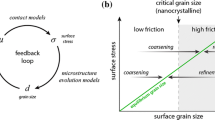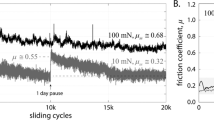Abstract
Dislocation studies, especially at large strains, are important for understanding materials aspects of tribological processes. Metallographic evidence shows that sliding causes very large plastic strains and strain gradients adjacent to the interface between the interacting materials. Dislocation densities increase, perhaps achieving saturation values. The resulting microstructures, including LEDS, are typical of those produced by other ways of producing large strains. Friction can be related to the dissipative processes associated with plastic deformation. Also, the material near the surface becomes unstable to local shear, allowing transfer of pieces of deformed material to the counterface. The transfer material is further deformed and mixed with the counterface material and/or environmental components to produce very fine grained structures, often in the nanocrystal range. Loose wear debris particles are commonly derived from this mixed material, not directly from the base material.
Similar content being viewed by others
Author information
Authors and Affiliations
Additional information
Received: 22 September 1997 / Accepted: 16 December 1997
Rights and permissions
About this article
Cite this article
Rigney, D. Large strains associated with sliding contact of metals. Mat Res Innovat 1, 231–234 (1998). https://doi.org/10.1007/s100190050046
Published:
Issue Date:
DOI: https://doi.org/10.1007/s100190050046




